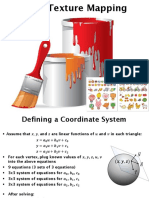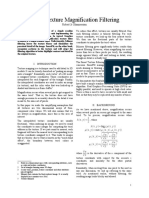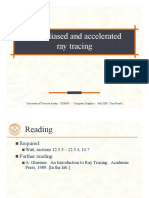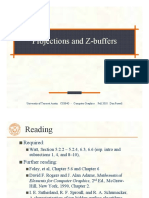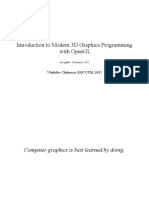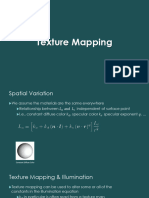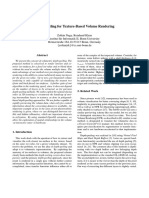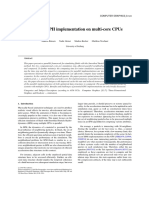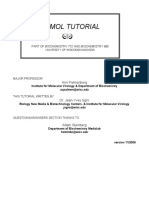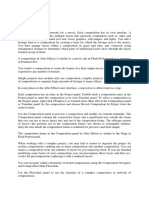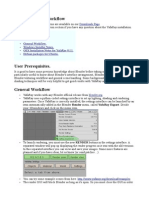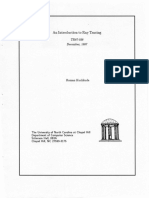Texture Mapping
University of Texas at Austin
CS384G - Computer Graphics
Fall 2010 Don Fussell
�Reading
Required
Watt, intro to Chapter 8 and intros to 8.1, 8.4, 8.6, 8.8.
Recommended
Paul S. Heckbert. Survey of texture mapping. IEEE Computer
Graphics and Applications 6(11): 56--67, November 1986.
Optional
Watt, the rest of Chapter 8
Woo, Neider, & Davis, Chapter 9
James F. Blinn and Martin E. Newell. Texture and reflection in
computer generated images. Communications of the ACM 19(10):
542--547, October 1976.
University of Texas at Austin
CS384G - Computer Graphics
Fall 2010 Don Fussell
�What adds visual realism?
Geometry only
Phong shading
Phong shading +
Texture maps
University of Texas at Austin
CS384G - Computer Graphics
Fall 2010 Don Fussell
�Texture mapping
Texture mapping (Woo et al., fig. 9-1)
Texture mapping allows you to take a simple polygon and
give it the appearance of something much more complex.
Due to Ed Catmull, PhD thesis, 1974
Refined by Blinn & Newell, 1976
Texture mapping ensures that all the right things happen
as a textured polygon is transformed and rendered.
University of Texas at Austin
CS384G - Computer Graphics
Fall 2010 Don Fussell
�Non-parametric texture mapping
With non-parametric texture mapping:
Texture size and orientation are fixed
They are unrelated to size and orientation of polygon
Gives cookie-cutter effect
University of Texas at Austin
CS384G - Computer Graphics
Fall 2010 Don Fussell
�Parametric texture mapping
With parametric texture mapping, texture size and
orientation are tied to the polygon.
Idea:
Separate texture space and screen space
Texture the polygon as before, but in texture space
Deform (render) the textured polygon into screen space
A texture can modulate just about any parameter diffuse
color, specular color, specular exponent,
University of Texas at Austin
CS384G - Computer Graphics
Fall 2010 Don Fussell
�Implementing texture mapping
A texture lives in it own abstract image coordinates parameterized by
(u,v) in the range ([0..1], [0..1]):
It can be wrapped around many different surfaces:
Computing (u,v) texture coordinates in a ray tracer is fairly
straightforward.
Note: if the surface moves/deforms, the texture goes with it.
University of Texas at Austin
CS384G - Computer Graphics
Fall 2010 Don Fussell
�Mapping to texture image coords
The texture is usually stored as an image. Thus, we need to
convert from abstract texture coordinate:
(u,v) in the range ([0..1], [0..1])
to texture image coordinates:
(utex,vtex) in the range ([0.. wtex], [0.. htex])
Q: What do you do when the texture sample you need lands
between texture pixels?
University of Texas at Austin
CS384G - Computer Graphics
Fall 2010 Don Fussell
�Texture resampling
We need to resample the texture:
A common choice is bilinear interpolation:
T(a,b) = T[i + " x , j + " y ]
= (1# " x )(1# " y )T[i, j] + " x (1# " y )T[i + 1, j]
+(1# " x )" y T[i, j + 1] + " x " y T[i + 1, j + 1]
University of Texas at Austin
CS384G - Computer Graphics
Fall 2010 Don Fussell
�Solid textures
Q: What kinds of artifacts might you see from using a
marble veneer instead of real marble?
One solution is to use solid textures:
Use model-space coordinates to index into a 3D texture
Like carving the object from the material
One difficulty of solid texturing is coming up with the
textures.
University of Texas at Austin
CS384G - Computer Graphics
Fall 2010 Don Fussell
10
�Solid textures (cont'd)
Here's an example for a vase cut from a solid marble
texture:
Solid marble texture by Ken Perlin, (Foley, IV-21)
University of Texas at Austin
CS384G - Computer Graphics
Fall 2010 Don Fussell
11
�Displacement mapping
Textures can be used for more than just color.
In displacement mapping, a texture is used to perturb the
surface geometry itself:
These displacements animate with the surface
Q: Do you have to do hidden surface calculations on Q?
University of Texas at Austin
CS384G - Computer Graphics
Fall 2010 Don Fussell
12
�Bump mapping
In bump mapping, a texture is used to perturb the normal:
Use the original, simpler geometry, Q(u), for hidden surfaces
Use the normal from the displacement map for shading:
~
N = normal[Q(u)]
Q: What artifacts in the images would reveal that bump
mapping is a fake?
University of Texas at Austin
CS384G - Computer Graphics
Fall 2010 Don Fussell
13
�Bump mapping example
Texture #1
(diffuse color)
University of Texas at Austin
Texture #2
(bump map)
CS384G - Computer Graphics
Rendered Image
Fall 2010 Don Fussell
14
�Displacement vs. bump mapping
Input texture
Rendered as displacement map over a rectangular surface
University of Texas at Austin
CS384G - Computer Graphics
Fall 2010 Don Fussell
15
�Displacement vs. bump mapping (cont'd)
Original rendering
Rendering with bump map
wrapped around a cylinder
Bump map and rendering by Wyvern Aldinger
University of Texas at Austin
CS384G - Computer Graphics
Fall 2010 Don Fussell
16
�Environment mapping
In environment mapping (also known as reflection mapping), a
texture is used to model an object's environment:
Rays are bounced off objects into environment
Color of the environment used to determine color of the illumination
Really, a simplified form of ray tracing
Environment mapping works well when there is just a single object or in
conjunction with ray tracing
Under simplifying assumptions, environment mapping can be
implemented in hardware.
With a ray tracer, the concept is easily extended to handle refraction as
well as reflection.
University of Texas at Austin
CS384G - Computer Graphics
Fall 2010 Don Fussell
17
�Combining texture maps
Using texture maps in combination gives even better effects.
Specular
coefficient
Diffuse
color
Environment map
(not necessary
in ray tracer)
University of Texas at Austin
CS384G - Computer Graphics
Material
properties
(coefficients
in shading
equation)
Fall 2010 Don Fussell
18
�Can define material by program
A surface shader computes the color of each ray that hits
the surface.
Example: Renderman surface shader
/*
* Checkerboard
*/
surface checker(float Kd=.5, Ka=.1) {
float smod = mod(10*s, 1);
float tmod = mod(10*t, 1);
if (smod < 0.5) {
if (tmod < 0.5) Ci=Cs; else Ci=color(0,0,0);
} else {
if (tmod < 0.5) Ci=color(0,0,0); else Ci=Cs;
}
Oi = Os;
Ci = Oi*Ci*(
Ka*ambient() +
Kd*diffuse(faceforward(normalize(N),I)));
}
University of Texas at Austin
CS384G - Computer Graphics
Fall 2010 Don Fussell
19
�How do we anti-alias textures?
We could just super-sample.
But textures (and shader programs) are a special case; we
can use true area integration!
- Approximate footprint as parallelogram
- Determine this approximate
footprint using discrete differences
University of Texas at Austin
CS384G - Computer Graphics
Fall 2010 Don Fussell
20
�Cost of filtering can be reduced
Store a pyramid of pre-filtered images:
During texture lookup, read from appropriate
level of the pyramid.
University of Texas at Austin
CS384G - Computer Graphics
Fall 2010 Don Fussell
21
�Next time: Hierarchical modeling
How do we represent translation and
rotation of complex objects using
hierarchies of transformations?
(Easy in principle, tough to get right in
practice)
Read:
Angel, sections 9.1 - 9.6 [reader pp. 169185]
OpenGL Programming Guide, chapter 3
[available online]
University of Texas at Austin
CS384G - Computer Graphics
Fall 2010 Don Fussell
22









